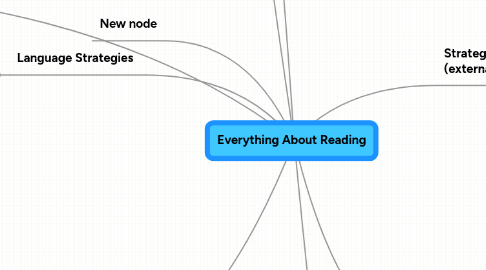Everything About Reading
by Kelly Geigner

1. Strategies for Deep Comprehension (internal)
1.1. predicting/making predictions
1.2. inferring/ making inferences & drawing conclusions
1.3. visualizing
1.4. connecting
1.5. analyzing
1.6. summarizing
1.7. synthesizing
1.8. skimming
1.9. critiquing
1.10. reflecting
1.11. main idea
1.12. interpreting figurative language
1.13. fact & opinion
1.14. author's purpose
1.15. recalling facts & details
2. Fluency
2.1. speed, rhythm, flexibility
3. Comprehension Skills
3.1. Inferential Skills
3.1.1. mood of the selection
3.1.2. author's purpose
3.1.3. conclusions
3.1.4. implied locations
3.1.5. implied times
3.1.6. character motivation and actions
3.1.7. meaning of figurative language
3.1.8. vocabulary meaning
3.1.9. pronoun referents
3.1.10. adverb referents
3.1.11. omitted words
3.1.12. implied main ideas
3.2. Literal Skills
3.2.1. details
3.2.2. cause & effect
3.2.3. sequence of events
3.2.4. problem of the story and its solution
3.3. Critical Skills
3.3.1. recognizing whether a piece of text is fact or opinion
3.3.2. identifying point of view
3.3.3. critiquing
3.3.4. making judgements
3.3.5. assessing writing style and tone
4. Procedures and Organization
5. Language Strategies
5.1. 1. They manipulate forms of speech to express meaning.
5.2. 2. They make good word choices that communicate clear messages.
5.3. 3. They use pronouns to stand for nouns.
5.4. 4. They use punctuation to clarify meaning and regulate fluency.
5.5. 5. They combine simple sentences into more complex ones.
5.6. 6. They organize related ideas into paragraphs, chapters, texts, and genres.
5.7. 7. They use dialogue to carry and extend meaning.
5.8. 8. They use figurative language to symbolize meaning.
5.9. 9. They build vocabulary through word relationships and patterns.
5.10. 10. They use transitional words and phrases.
6. New node
7. Strategic Behaviors (external)
7.1. rereading
7.2. previewing or surveying text
7.3. asking questions; before, during, after
7.4. reading aloud to clarify behaviors
7.5. using story structure, text genre, writing conventions
7.6. using texts aids to illuminate and extend meaning
7.7. marking texts and recording notes
7.8. using context and parts of words to infer meaning/ word meaning in context
7.9. writing in reading response logs
7.10. discussing ideas with others
8. Text Structures
8.1. cause/effect
8.2. time order
8.3. problem/solution
8.4. comparison/contrast
8.5. descriptive
8.6. chronological/sequence
9. Nieuw knooppunt


